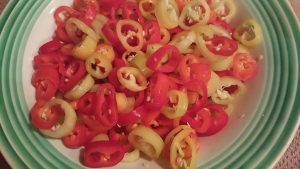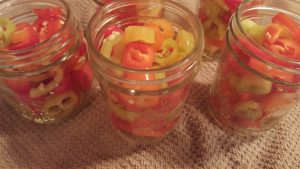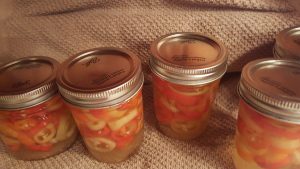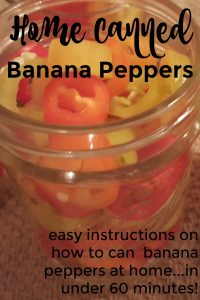The beauty of canning banana peppers is that it’s extremely quick. In fact, banana pepper rings only process five minutes in the boiling water canner, making it a snap to fit a small one-pound batch into your busy schedule.
The pickling liquid I make is a little tart, a little savory, and a little salty. But it’s a well-balanced flavor that combines beautifully with the sweet, mild heat of the banana peppers.
Of course, they are lovely on homemade pizza, salads. Or enjoy them chopped up and added to pimiento cheese or salsa recipes.
I love canning. It’s a great way to spend time in the kitchen. I learned from my mother, an avid home canner. There’s something comforting in following the tradition of home canning. My mother is from a long line of farmers who grew and preserved their own foods to sustain their families during the long Erie, Pennsylvania winters.

HOME-CANNED BANANA PEPPERS IN UNDER 60 MINUTES
SUPPLIES:
- A tall boiling water canner pot
- Air bubble removing tool
- (5) 1/2 pint jars
- (5) lids and rings
- knife
- cutting board
- ladle
- canning funnel
- lid lifting magnet
- bowl
- jar lifter tool
INGREDIENTS:
- 1 pound of banana peppers
- 2 c. white vinegar
- 1 cup water
- 2 tsp canning salt
- 2 tsp garlic powder
- 1/2 tsp celery seed
- 2/3 cup granulated sugar
- 3 tsp Fruit Fresh
DIRECTIONS FOR CANNING BANANA PEPPERS:
- Firstly, prepare your boiling water canner. Then fill it about halfway with water, and get the water rolling.
- Sterilize your jars and rings. If you’re reusing rings, look them over and discard if they are dented, rusty, or damaged. Some people sterilize their jars on a sterile cycle in their dishwasher. However, I don’t have a dishwasher. I boil mine for 10 minutes once the canner gets rocking and rolling.
- Have a small pot of water on simmer for the canning lids. Then drop your lids and keep them on a low simmer as you complete the canning process.
- Cut the banana peppers into rings. You can remove the seeds if you want them milder.
- Pack them as tightly as possible into the 5 half-pint jars. They should almost come to the top. If you leave too much space, they will float to the top of the jar and not be nestled down in all that savory juice.


ENJOY YOUR HOME CANNED BANANA PEPPERS
That’s it, you’re done! After a little while, you while start to hear that satisfying plink as the lids seal. But, do NOT give in to the temptation to poke down the lids. Because if you do, you won’t know which ones actually sealed or if you have one that did not.
Any jars that don’t seal can either be reprocessed in the canner or put in the fridge to eat up. But I usually don’t reprocess, I find it easy just to go on and eat them!
See how easy? So if you’re new to canning, this is a fantastic first canning effort. It’s quick and not too messy. In fact, you get done in under sixty minutes with this small batch method. As a result, you’ll have banana peppers to top your favorite sandwiches, wraps, and pizza to enjoy in the months to come.
Have a happy DIY day!


